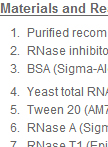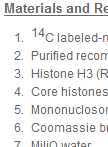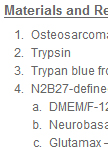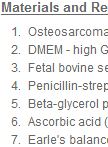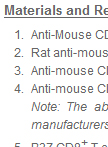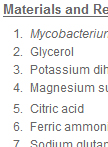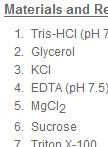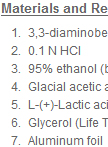往期刊物2012
卷册: 2, 期号: 24
生物化学
UV Cross-linking Assay and Competition Assay
RNA与RNA结合蛋白互作研究-紫外交联联合探针竞争
UV cross-linking assay is a standard method used to detect protein-RNA interaction. This method takes advantage of UV irradiation to trigger the formation of the covalently bonded RNP (ribonucleoprotein) complex that is more stable and makes it possible to be isolated in the denaturing conditions. Briefly, 32P-labeled RNA probe and proteins are incubated to form RNP complexes spontaneously; the mixture is then exposed to UV irradiation, followed by treatment with ribonuclease to remove RNA fragments not covalently bound to protein. The oligoribonucleotide-protein complexes are analyzed by SDS-PAGE, and the signals visualized by phosphorimaging. Competitive UV cross-linking assay is a method to determine the protein binding sites and specificity on the RNA substrate. In this assay, the excessive amounts of unlabeled competitor RNA are pre-incubated with the proteins prior to the addition of 32P-labeled RNA probe. If the competitor RNA comprises the protein binding region, the bindings between proteins and RNA probes will be competed and the radioactive binding signals will be reduced.
Histone Methyltransferase Assay in vitro
组蛋白甲基转移酶活性体外检测试验
Histone methylation is an important epigenetic modification that plays important roles in plant development and growth. Histone methytransferases are the enzymes to establish histone methylation and here we describe a simple and effective protocol for detecting methyltransferase activity and specificity in vitro.
癌症生物学
Sphere Formation (Osteosphere/Sarcopshere) Assay
球体形成(骨球体/肌球体)试验
Self-renewing cells from adult tissue (such as bone) that represent a progenitor population can be grown in suspension cultures in the presence of defined serum-free medium. Progenitor cells can be identified by this property of anchorage-independent growth in suspension cultures. These spherical clusters of progenitor bone cells growing under non-adherent conditions are called osteospheres. Such progenitor populations often possess characteristics of multipotency and can differentiate into multiple mesenchymal lineages. Cancer cells capable of growing in suspension have also been reported in osteosarcomas, tumors of the bone tissue. These spherical colonies formed from single cells (clonal) in non-adherent conditions are generally considered to represent self-renewing, stem-like cells and can be employed for other assays such as multipotency and limiting dilution analysis (LDA).
Osteogenic and Adipogenic Differentiation of Osteosarcoma Cells
骨肉瘤细胞的成骨和生脂分化
Osteosarcomas are the most common primary, non-hematologic malignant tumors in childhood and adolescence, comprising almost 60% of all bone sarcomas. Although these tumors are osteoblastic in nature, the characteristics of the specific tumor-initiating cells are unclear. Osteosarcomas contain highly proliferative undifferentiated malignant cells with a disrupted bone differentiation program. Cancer stem cells (CSCs) that have tumor-initiating properties and capacity of symmetric and asymmetric division have now been described in many solid tumors. For osteosarcomas, the CSC hypothesis has received support from recently reported findings that both human and murine osteosarcomas contain a sub-population of multipotent cells that that express various mesenchymal stem cell surface markers and are capable of undergoing differentiation in multiple mesenchymal lineages such as osteoblasts and adipocytes. Differentiation into these different lineages can be easily assessed by growing cells in specific medium and assaying for differentiation markers.
免疫学
In vitro Ag Cross-presentation and in vivo Ag Cross-presentation by Dendritic Cells in the Mouse
小鼠树突细胞进行抗原交叉递呈的体外和体内实验
Antigen cross presentation is important for effective immune responses to tumors and viral infections. Dendritic cells are professional antigen presenting cells and are unique in their ability to cross-present exogenous antigens on MHC class I molecules and activate antigen specific cytotoxic T cells. This protocol describes antigen cross presentation by dendritic cells (DCs) (bone marrow derived DCs and splenic DCs) in an in vitro and in an in vivo assay system using soluble ovalbumin protein.
微生物学
Purification of 38kDa Antigen of Mycobacterium tuberculosis by Two Dimensional Preparative Electrophoresis
采用二维双向电泳法纯化结核杆菌的38kDa抗原
Serodiagnosis of tuberculosis using purified native antigens is one of the approach for the early detection of TB. This protocol gives the details for growing Mycobacterium tuberculosis in liquid culture and one proven way to get a good yield of the total secreted antigens in the culture supernatant. In addition the procedure for purification of the 38 kDa antigen from the total culture filtrate antigens is also explained. 38 kDa is one of the specific antigen for Mycobacterium tuberculosis complex and in this particular study it was used as one of the antigens for serodiagnosis of different category of tuberculosis patients.
植物科学
Nuclear Extraction from Arabidopsis thaliana
拟南芥中细胞核的分离
This protocol is to isolate nuclei from Arabidopsis cells. They can be further used for other experiments, such as nuclear protein detection, nuclear protein immunoprecipitation and so on.
DAB Staining and Visualization of Hydrogen Peroxide in Wheat Leaves
利用DAB染色原位检测小麦叶片中的过氧化氢
The production of hydrogen peroxide (H2O2) has been recognized as an important feature of plant cells that undergo programmed cell death (PCD) during host-pathogen interaction. Thordal-Christensen et al. (1997) first described a method using chemical 3,3-diaminobenzidine (DAB) to detect the presence and distribution of H2O2 in barley leaves challenged by the powdery mildew fungus (Thordal-Christensen et al., 1997). Since then, this method has been adapted to many other plant species for in situ detection of H2O2. Here, we describe a modified protocol to stain and visualize H2O2 production in wheat leaves during infection by the necrotrophic fungus, Stagonospora nodrum or infiltration by the necrotrophic effectors produced by the fungus. The short version of this method has been reported in (Liu et al. 2012).


